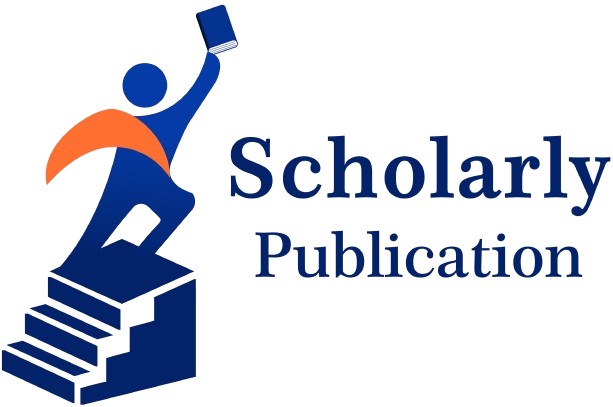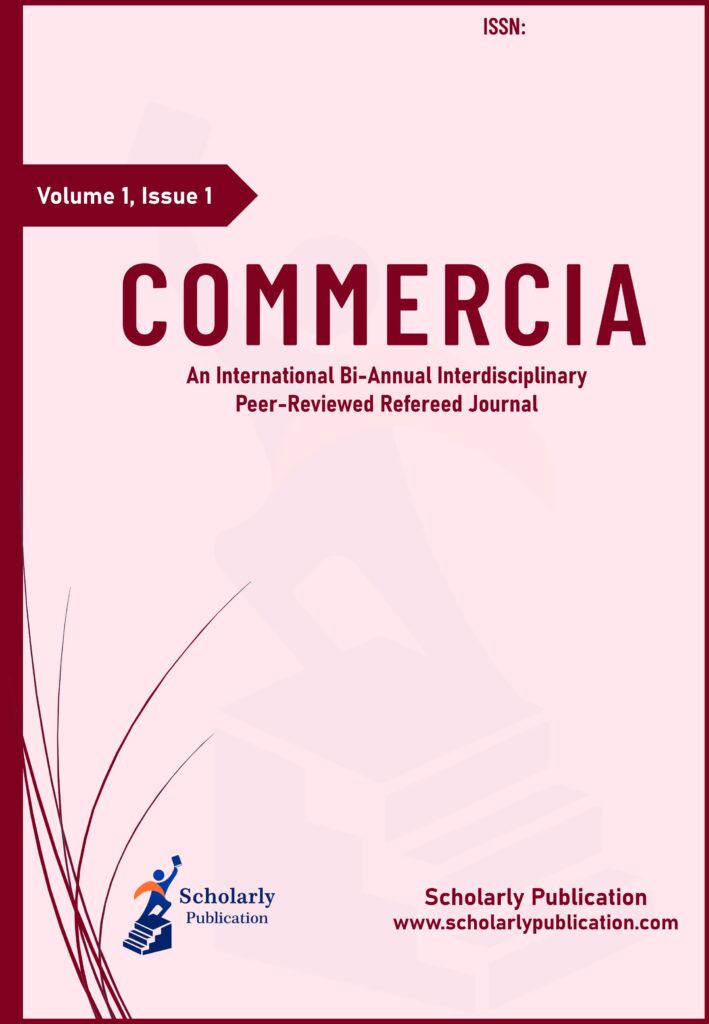Sustainable Development through Green Human Resources Management: Perceptions from MSMEs in Northern India
Volume 1, Issue 2, Article Number: 252001 (2025)
Home >> Commercia >> Volume 1, Issue 2
1Research scholar, Department of Commerce, SRM University, Sonipat, Haryana, India, 131029
2Assistant Professor, Govt College Kharkhoda, Sonipat, Haryana, India, 131402
3Assistant Professor, Department of Commerce, SRM University, Sonipat, Haryana, India, 131029
*Corresponding Author: poonam.g@srmuniversity.ac.in
Received: 26 June 2025 | Revised: 12 July 2025
Accepted: 18 July 2025 | Published Online: 20 July 2025
DOI: https://doi.org/10.5281/zenodo.16229992
© 2025 The Authors, under a Creative Commons license, Published by Scholarly Publication
Abstract
Given the escalating threat of pollution, it is evident that Micro Small and Medium-sized Enterprises (MSMEs) offer a formidable engine for long-term growth, especially in new countries like India. This paper examines the adoption and influence of Green Human Resource Management (Green HRM) practices within MSMEs of the Delhi-NCR Region, explicitly aimed at their green sustainable concept. Using the structural equation modeling methodology as the primary analytic technique, a total of 289 responses from companies operating in Northern India were collected. The scholarly article delves deeply into the key facets of Green HRM, as well as the ecological implications of these approaches within an organizational setting. It explores dimensions such as eco-friendly recruitment tactics, environmental training programs, performance reviews with a focus on sustainability, collaborative efforts between employees, and involving workers in green initiatives. The results notably illustrate a significant linkage between Green HRM practices and boosting sustainable functioning in small to medium manufacturing and service enterprises. These conclusions underscore the strategic importance of incorporating environmentally conscious HRM strategies to achieve long-term terrestrial and financial goals. The innovative research provides beneficial insights for policymakers, HR specialists, and small business leaders seeking to harmonize their human capital policies with aims of environmental preservation. Overall, the findings highlight both the opportunities and difficulties related to adopting Green HRM in modest companies operating in an emerging economy.
Keywords
Green HRM, Sustainability, MSME, Smart-PLS, Green Performance Appraisal
References
Ahmad, S., Javed, U., Sharma, C., & Siddiqui, M. S. (2025). Green Human Resource Management: Analyzing sustainable practices and organizational impact through a Word2Vec approach. Green Technologies and Sustainability, 3, 100224.
[View Article] [Google Scholar]
Anshima, Sharma, D., & Bhardwaj, B. (2025). Green human resource management practices and sustainable development in India: A systematic literature review and future research agenda. Social Sciences & Humanities Open, 11, 101420.
[View Article] [Google Scholar]
Din, A. U., Yang, Y., & Zhang, Y. (2025). The psychological benefits of green HRM: A study of employee well-being, engagement, and green behavior in the healthcare sector. Acta Psychologica, 254, 104823.
[View Article] [Google Scholar]
Dutta, D., Srivastava, P., Zabin Memon, N., & Vedak, C. (2025). Inclusive and sustainable economic growth for MSME firms: examining the impact of sustainable HRM practices on women’s well-being. International Journal of Manpower, 46, 697–714.
[View Article] [Google Scholar]
Faeni, D. P., Oktaviani, R. F., Riyadh, H. A., Faeni, R. P., & Beshr, B. A. H. (2025). Green Human Resource Management and Sustainable Practices on Corporate Reputation and Employee Well-being: A model for Indonesia’s F&B industry. Environmental Challenges, 18, 101082.
[View Article] [Google Scholar]
Fawehinmi, Olawole, Yusliza, M. Y, Wan Kasim, Wan Zulkifli, Mohamad, Zaleha, & Sofian Abdul Halim, Muhammad Abi. (2020). Exploring the Interplay of Green Human Resource Management, Employee Green Behavior, and Personal Moral Norms. SAGE Open, 10, 2158244020982292.
[View Article] [Google Scholar]
Fornell, C., & Larcker, D. F. (1981). Evaluating Structural Equation Models with Unobservable Variables and Measurement Error. Journal of Marketing Research, 18, 39.
[View Article] [Google Scholar]
Gomes, D. R., Ribeiro, N., Gomes, G., Ortega, E., & Semedo, A. (2024). Green HRM’s Effect on Employees’ Eco-Friendly Behavior and Green Performance: A Study in the Portuguese Tourism Sector. Sustainability, 16, 10005.
[View Article] [Google Scholar]
Gupta, A., & Jangra, S. (2024). Green human resource management and work engagement: Linking HRM performance attributions. Sustainable Futures, 7, 100174.
[View Article] [Google Scholar]
Gyensare, M. A., Adomako, S., & Amankwah-Amoah, J. (2024). Green HRM practices, employee well-being, and sustainable work behavior: Examining the moderating role of resource commitment. Business Strategy and the Environment, 33, 3129–3141.
[View Article] [Google Scholar]
Hair, J. F., Ringle, C. M., & Sarstedt, M. (2013). Partial least squares structural equation modeling: Rigorous applications, better results and higher acceptance. Long Range Planning, 46, 1–12.
[View Article] [Google Scholar]
Jum’a, L., & Bushnaq, M. (2024). Investigating the role of flexibility as a moderator between supply chain integration and firm performance: the case of manufacturing sector. Journal of Advances in Management Research, 21, 203–227.
[View Article] [Google Scholar]
Kamboj, Jyoti, & Anthonysamy, E. (2024). Mapping the green human resource management practices: A systematic scoping review and its implications for employees’ well-being. Human Systems Management, 43, 932–970.
[View Article] [Google Scholar]
Kumar, J. S., & Shobana, D. (2024). An Analysis of the Role of Small and Medium Enterprises (SMEs) in Enhancing India’s Economic Development, In New Horizons of Research in Business Management, Virudhunagar Hindu Nadars’ Senthikumara Nadar College, Virudhunagar 133–144.
Kuo, Y.-K., Khan, T. I., Islam, S. U., Abdullah, F. Z., Pradana, M., & Kaewsaeng-on, R. (2022). Impact of Green HRM Practices on Environmental Performance: The Mediating Role of Green Innovation. Frontiers in Psychology, 13, 916723.
[View Article] [Google Scholar]
Maheshwari, M., Samal, A., & Bhamoriya, V. (2020). Role of employee relations and HRM in driving commitment to sustainability in MSME firms. International Journal of Productivity and Performance Management, 69, 1743–1764.
[View Article] [Google Scholar]
Mathew, N., & Varaprasad, G. (2025). Superimposition of adoption model on the hierarchy of needs – a case of four-wheeler electric vehicles in India. International Journal of Services and Operations Management, 51, 221–240.
[View Article] [Google Scholar]
Montalvo-Falcón, J. V., Sánchez-García, E., Marco-Lajara, B., & Martínez-Falcó, J. (2023). Green human resource management and economic, social and environmental performance: Evidence from the Spanish wine industry. Heliyon, 9, e20826.
[View Article] [Google Scholar]
Mura, M., Longo, M., Boccali, F., Visani, F., & Zanni, S. (2024). From outcomes to practices: Measuring the commitment to sustainability of organisations. Environmental Science & Policy, 160, 103868.
[View Article] [Google Scholar]
Prasanna, R., Samarakoon, J., Kumara, S., Naradda Gamage, S., Ekanayake, E., Rajapakshe, P., Abeyrathne, G. A. K. N. J., & Rajapakshe, S. (2019). Sustainability of SMEs in the Competition: A Systemic Review on Technological Challenges and SME Performance. Journal of Open Innovation: Technology, Market, and Complexity, 5, 100.
[View Article] [Google Scholar]
Sarstedt, M., Hair, J. F., Cheah, J.-. H., Becker, J.-. M., & Ringle, C. M. (2019). How to specify, estimate, and validate higher-order models. Australasian Marketing Journal, 27.
[View Article] [Google Scholar]
Shelly, R., Sharma, T., & Bawa, S. S. (2020). Role of Micro, Small and Medium Enterprises in Indian Economy. International Journal of Economics and Financial Issues, 10, 84–91.
[View Article] [Google Scholar]
Vadithe, R. N., Rajput, R. C., & Kesari, B. (2025). Impact of Green HRM implementation on organizational sustainability in IT sector: A mediation analysis. Sustainable Futures, 9, 100507.
[View Article] [Google Scholar]
Varshney, T., & Rajwanshi, R. (2019). Examining social capital and participation in networking sites. Journal of Advances in Management Research, 16, 645–658.
[View Article] [Google Scholar]
Zihan, W., & Makhbul, Z. K. (2024). Green Human Resource Management as a Catalyst for Sustainable Performance: Unveiling the Role of Green Innovations. Sustainability, 16, 1453.
Cite This Article
K. Chauhan and P. Bhatt, “Sustainable Development through Green Human Resources Management: Perceptions from MSMEs in Northern India,” Commercia 1(2) (2025) 252001. https://doi.org/10.5281/zenodo.16229992
Rights & Permission
This is an open access article published under the Creative Commons Attribution (CC BY) International License, which allows unrestricted use, distribution, and reproduction in any medium, provided the original work is properly cited. No permission is needed to reuse this content under the terms of the license.
For uses not covered above, please contact the Scholarly Publication Rights Department.

